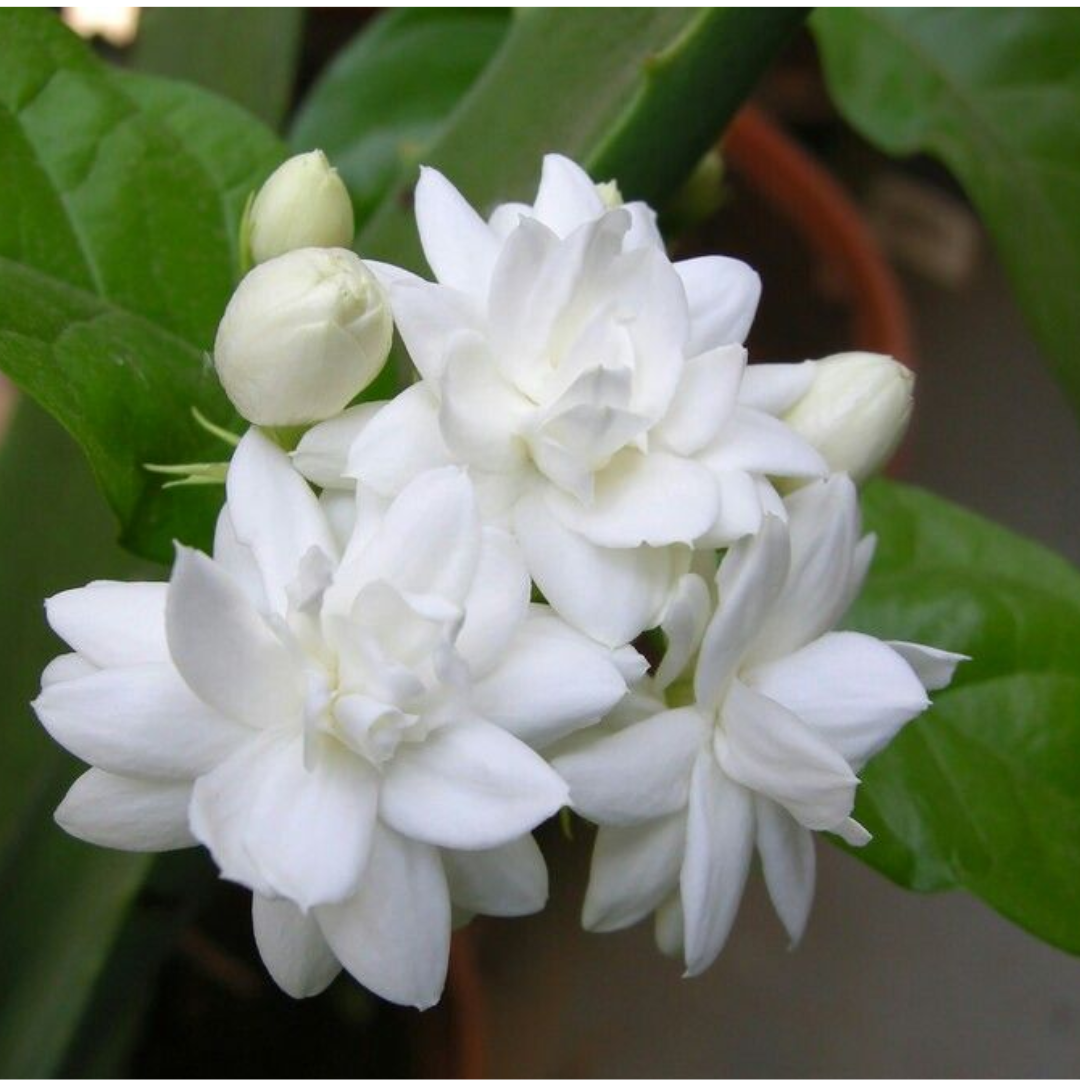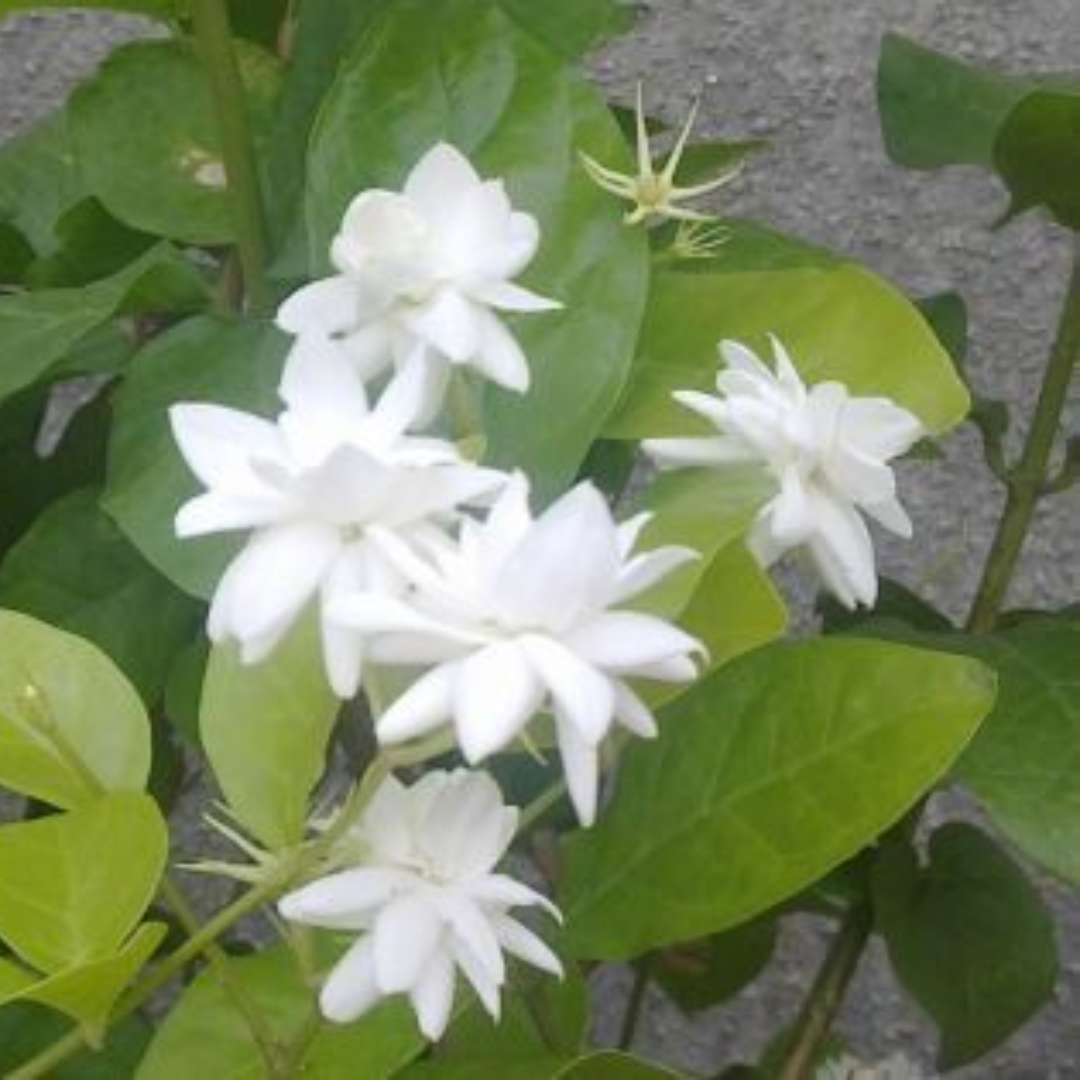


Green Paradise Offers Arabian Jasmine
Mogra Plant
About Arabian Jasmine Mogra
Arabian Jasmine, also known as Mogra or Mograwadi, is a popular flowering plant known for its beautiful and fragrant white flowers. It belongs to the genus Jasminum and is native to South Asia, specifically the Indian subcontinent. Arabian Jasmine is highly regarded for its captivating scent and is widely used in perfumes, cosmetics, and traditional ceremonies.
Here are some key features and characteristics of Arabian Jasmine Mogra plant:
Appearance:
- Arabian Jasmine is a vigorous, evergreen vine or shrub that can grow up to 6 to 10 feet (1.8 to 3 meters) in height.
- It has shiny, dark green leaves arranged opposite each other along the stems.
- The plant produces clusters of small, delicate, star-shaped white flowers that emit a sweet, intense fragrance.
Fragrance:
- The fragrance of Arabian Jasmine flowers is its most notable characteristic.
- The scent is highly aromatic, sweet, and intoxicating, often described as rich and heavenly.
- The fragrance is particularly strong during the evening and night, which adds to its allure.
Cultivation:
- Arabian Jasmine is relatively easy to grow and is popular among gardeners and flower enthusiasts.
- It prefers warm climates and thrives in tropical and subtropical regions.
- It requires well-drained soil and prefers a sunny location, although it can tolerate partial shade.
- The plant benefits from regular watering and appreciates a slightly acidic soil pH.
Propagation:
- Arabian Jasmine can be propagated through stem cuttings.
- Select healthy, non-flowering stems and trim them to about 6 inches (15 cm) in length.
- Remove the lower leaves and plant the cutting in a well-draining potting mix.
- Keep the soil moist until roots develop, and then gradually reduce watering.
- It is also possible to propagate Arabian Jasmine from seeds, although it takes longer to establish.
Uses:
- Arabian Jasmine has been cultivated for centuries for its ornamental value and fragrance.
- It is commonly used in gardens, landscapes, and as a potted plant.
- The flowers are highly prized for making garlands, and floral arrangements, and for religious and ceremonial purposes.
- Arabian Jasmine's essential oil is extracted and used in perfumes, soaps, and candles.
Symbolism:
- Arabian Jasmine carries cultural and symbolic significance in many societies.
- It is associated with love, purity, sensuality, and beauty.
- The flowers are often used in weddings, festivals, and other celebrations as a symbol of auspiciousness and as offerings to deities.
In addition to its aesthetic and aromatic qualities, Arabian Jasmine is believed to have some medicinal properties. It has been traditionally used in Ayurvedic and traditional medicine to alleviate stress, anxiety, and depression, as well as to treat skin conditions and digestive disorders. However, before utilizing any plant for therapeutic purposes, consult with a healthcare practitioner.
Overall, the Arabian Jasmine Mogra plant is a cherished and enchanting flower that adds elegance, fragrance, and cultural significance to gardens, ceremonies, and personal spaces.
How To Grow & Care Arabian Jasmine Mogra Plant
Arabian Jasmine, also known as Mogra or Jasmine sambac, is a beautiful flowering plant with fragrant white flowers.
Here are some guidelines on how to grow and care for Arabian Jasmine:
Planting:
- Choose a well-draining pot or an area in your garden with fertile soil that receives at least 4-6 hours of direct sunlight per day.
- Arabian Jasmine can be grown from seeds, cuttings, or nursery-bought plants.
- If using seeds, soak them overnight before planting.
- Plant the seeds or the cuttings in the soil at a depth of about 1 inch (2.5 cm), ensuring proper spacing between multiple plants.
Watering:
- Arabian Jasmine prefers moderate watering.
- Water the plant thoroughly when the top inch (2.5 cm) of soil feels dry, but avoid overwatering, as it can lead to root rot.
- During hot and dry conditions, the plant may need to be watered more frequently.
- Adjust the watering schedule accordingly.
Fertilization:
- Feed your Arabian Jasmine plant with a balanced, water-soluble fertilizer once a month during the growing season (spring and summer).
- Use a fertilizer specifically formulated for flowering plants or a general-purpose fertilizer with equal NPK (nitrogen, phosphorus, potassium) ratios.
- Follow the dosage and application method instructions on the fertilizer container.
Pruning:
- Regular pruning is beneficial for Arabian Jasmine plants to maintain their shape and encourage healthy growth.
- Prune after the flowering season to remove dead or diseased branches, promote better air circulation, and stimulate new growth.
- To encourage ongoing flowering and to reduce seed formation, pinch off spent flowers.
Support:
- Arabian Jasmine is a climbing vine and benefits from support structures like trellises, stakes, or fences.
- As the plant grows, gently tie the vines to the support structure to guide their growth and prevent them from trailing on the ground.
Pests and Diseases:
- Arabian Jasmine is generally resilient but can be susceptible to pests like aphids, mealybugs, and spider mites.
- Inspect the plant regularly, and if you notice any infestations, treat them with appropriate organic or chemical pest control methods.
- Ensure good air circulation around the plant to prevent fungal diseases, such as powdery mildew.
- Avoid overwatering and provide ample space between plants.
Winter Care:
- Arabian Jasmine is a tropical plant that prefers warm temperatures.
- If you live in a region with cold winters, it's best to grow it in containers that can be moved indoors during the colder months.
- Place the plant near a sunny window or under grow lights and reduce watering frequency during winter.
